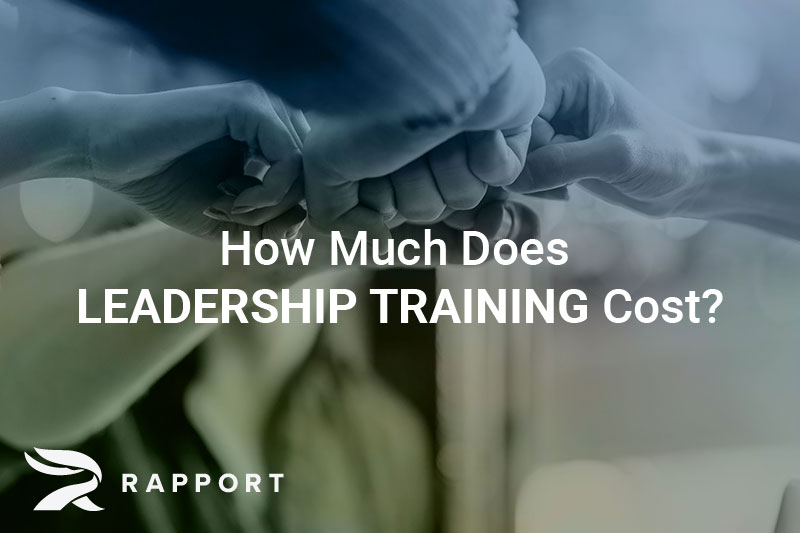How Much Does Leadership Training Cost?

Oftentimes, a manager rises to his or her position after excelling at the specific job they were hired to perform. This provides a wonderful bank of information for employees to tap into when they have industry-specific, job responsibility-related questions. At the same time, your company’s leaders may be lacking skills necessary to lead.
They may be lacking in communication skills, decision-making skills, the ability to delegate work and empower a team, creativity, or the interpersonal skills necessary to manage employee relationships.
Less-than-perfect leadership skills affect the individual and also trickle down to all of the employees that report to him or her, other departments in the organization, vendors, customers, higher-ups… you get the point.
Ideally, your company will provide leadership training to employees that are already in a managerial role and possibly even other employees to create a high-performing team. If you have already considered this investment or are only now beginning to entertain the idea, you may be curious how much this type of training will cost.
How Much Does Leadership Training Cost?
You want a straight answer... a dollar amount that you can plug into your budget and be done with it. It's not that simple. The cost of leadership training varies drastically across the board. Why? Because it can be delivered in many different mediums.
Leadership Development Books
You can also learn a lot from books that cost in the realm of $20. Holding your team accountable for reading the book is a challenge. Plus, reading is often not enough. People on your team have different learning styles, and in order to get the greatest benefit from a professional or personal development book, an individual needs to work through the exercises provided and apply what they learn to their daily activities.
In-House Workshops and Classes
The next level of training would be a workshop or class provided by your HR department. You may have an entire training department dedicated to teaching the skills necessary to properly serve in a role. This can be a great option if you have a lot of employees.
For those organizations with a smaller workforce, it may not pay to have employees focused entirely on training. Plus, with an average salary of $52,000 a year for corporate trainers, you can't possibly employ a full-time expert in every topic you need addressed. It pays off to work on the business from outside it.
Classroom-Based Leadership Training
Some employees may already be looking at professional development opportunities outside of the office. There are many community colleges and universities that offer leadership training classes. These can cost between $1,500 and $4,000 depending on the school. You may consider giving your employees the go-ahead to sign up and then reimburse them for the credits. This will require a several week (if not month) commitment on their end.
Immersive Leadership Training Programs and Retreats
If you don't have a large company, or prefer to stretch your employees' comfort zones by sending them out for training, there are multi-day leadership programs and retreats that fit the bill. These will run you around $1,500 and up depending on the program you choose. However, your employees will be completely immersed in the experience and will likely return to their jobs and their lives as new people.
One-on-One Coaching
The most personally involved option is one-on-one coaching. There are leadership coaches and consultants that will meet with your key employees to identify their strengths, weaknesses, their goals, and the steps they need to take to reach them. They will teach an employee the skills they need to be a better leader and create a plan for them to follow.
These coaching situations can cost anywhere between $75 and $500 per hour. Depending on your needs, coaching is extremely beneficial for executive and management staff, and often can be done for full teams.
Factors That Affect Program Cost
Now that you understand the different types of leadership training, it's important to examine the factors that will affect your investment.
1) What type of training will they participate in? The more personalized attention they receive, the more costly it will be.
2) Where will it be held? The cost of providing web-based training or in-house training with a dedicated HR employee will be considerably less than having to fly in a leadership expert, putting them up, providing a food budget, etc. If you have to transport your employees to a different venue or to a different city or state, the cost of travel will need to be factored in.
3) Is the training customized, or can you get away with a standard program? If a trainer has to alter their regular offerings to suit your specific needs, he or she will often charge for their time.
4) How long and in depth will the program be? The cost of a 3-hour course is going to be significantly less than a 2- to 3-day training. The question is whether or not your employees can gain the expertise they need in a matter of hours.
5) Who will provide the training? Like everything in life, there are varying levels of experience, quality, and value. You can hire someone with little-to-no experience in leadership roles that could likely deliver a decent program to your employees. However, a more seasoned leader will have personal experience to draw upon and won't just be passing along "textbook knowledge" to your team.
How Much Does Leadership Training SAVE?
If you spend the majority of your time focused on how much leadership training will cost, you're missing out on the real question... how much will it save?
Training can be expensive. But do you know what can be even more expensive? High turnover. Low morale. Not attracting the best talent because you've developed a reputation of having poor leadership.
Puts this in perspective, doesn't it?
Benefits of Leadership Training
Now that you understand what's at stake if you don't provide the training and professional development needed, let's examine the benefits of when you do.
Employee Retention
Employees will stay for a number of reasons: they like the work environment, they appreciate having strong leaders, and they see the potential to move up in their own careers.
Professional Development
Managers are hired or promoted; leaders are developed. Your key people will learn what it takes to lead a team of people and keep them inspired, motivated, and working together towards a common goal.
Improved Communication
Assertive communication is one of the hallmarks of good leadership. A leader must be able to give (and accept) feedback, clearly communicate their ideas to others, be empathetic of their team members, deal with conflict, and provide a positive example for others to follow.
Prepare for the Future
While your development investments may be focused on those in leadership roles at the moment, consider offering training to people who are not yet supervisors or managers in your organization. No matter how well you treat your employees, there will always be a certain level of attrition. You can prepare for that and lessen the blow of leadership leaving by having eager (trained) leaders waiting to step into these roles.
Improves Teamwork
When your leaders know how to foster communication and resolve conflict among their employees, teamwork will improve, and employees will be happier and more productive as they work together.
Clearer Vision
While a big part of leadership is handling the employees under them, an often-forgotten aspect is developing a vision of where the company will go. A good leadership training program will include creativity development. With a newfound view of the world, leaders are able to envision a more expansive future and share that vision with their team.
Everyone Benefits
Whenever you see dysfunction in a company, it's rarely, if ever, the fault of front-line employees. Rather, the challenges are flowing from management down. The chaos at the bottom is merely a symptom of the issues above.
On the other hand, when your company employs strong leaders, their confidence, abilities, and training will spread to everyone they work with.
How Much Do Companies Spend on Leadership Development?
If you think you're alone in your desire to provide leadership training to your employees, you are incorrect.
A research study by Bersin in 2012 found that American companies spend approximately $14 billion dollars on leadership development training each year. In fact, 36% of companies (the largest segment) polled in a 2017 survey by Chief Learning Officer magazine invested between $1,000 and $3,999 per person on Leadership development.
When it comes to leadership training and professional development in your organization, you'll likely get what you pay for. If you take the time and spend the money to invest in your employees and foster their talent, you'll get happier, healthier, more loyal, and more productive employees in return.
Why Rapport Is One of the Best Leadership Training Programs
Rapport is one of the best investments you can make in your leaders. With 2.5-day, hands-on immersive training, your employees will gain insights about themselves that make them better employees, leaders, and people.
It Can Be On or Off Location
Rapport’s training classes can be held at the JFDI Executive Retreat center in Alamo, NV, or on an offsite location closer to your offices depending on organizational needs. The JFDI Executive Retreat in Alamo, offers stress-free transport from the main office in Las Vegas, comfortable lodging, world-class food, and the most intense, life-changing training they can imagine. Classes performed outside of the executive retreat are held in a variety of locations designed to meet the needs of the organizations they are serving and class being taken.
It’s Intimate
Rapport’s Leadership Training courses offers a low participant-to-facilitator ratio, allowing for the opportunity for all participants to actively participate and receive individual attention. They'll identify their leadership style, learn to communicate better, and begin to see the world differently.
It’s Not Just a Lecture
Hands-on, experiential training is important to the lasting success of a program. Individuals learn differently, and a "lecture-style" class setting is not ideal for everyone. Lessons learned during this type of training may be lost within weeks (if not days) of the initial class. When an individual is immersed in experiential training, they internalize the lessons and can draw upon them for years to come. It changes how they think, act, and see themselves.
It’s an Experience
As a multiple-day retreat setting, Rapport will provide the best bang for your proverbial buck. The best part is that the benefits don't stop when participants return to their jobs and their everyday lives. The knowledge that they've gained about leadership and about themselves will inspire everyone they meet.
Your employees are the heart and soul of your organization. Without them, your business wouldn't run the way it's meant to, and the goals you've set would never be reached. Rather than concerning yourself with the cost of leadership development for your key people, examine the challenges that poor leadership can cause, review the benefits of developing your team, and ask yourself, "Can I afford not to provide all of the training and development opportunities possible?"



